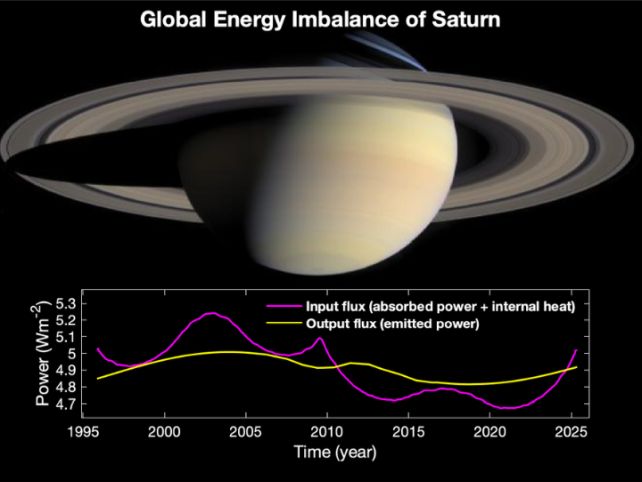ARTICLE AD
Will the shenanigans of Saturn never end? Scientists have found that the ringed planet sports a massive, seasonal energy imbalance across its globe.
The discovery marks a turning point in our understanding of weather and climate on gas giant planets, their long-term evolution, and the ongoing changes.
"This is the first time that a global energy imbalance on a seasonal scale has been observed on a gas giant," says physicist Liming Li of the University of Houston. "Not only does this give us new insight into the formation and evolution of planets, but it also changes the way we should think about planetary and atmospheric science."
Here's what that means. The powerful light of the Sun streaming throughout the Solar System imbues everything it hits with energy. Energy is also lost by planets in the form of cooling, radiating out into space primarily in the form of thermal radiation.
In the case of gas giant planets, including Saturn, there's also an energy source churning away deep inside which affects the planet's climate from within.
A team led by atmospheric scientist Xinyue Wang of the University of Houston was studying Cassini data on Saturn to examine its brightness when they noticed something interesting. The difference between how much energy it absorbs compared to how much energy it emits can vary by up to 16 percent, with fluctuations that align with the planet's seasons.
This, the researchers found on closer inspection, has to do with how far Saturn is from the Sun at any given time. Saturn's orbit isn't perfectly circular; it's actually elliptical – a property called eccentricity – leading to a distance variation of nearly 20 percent between its closest distance to the Sun and its farthest.
 A graphic showing the energy imbalance of Saturn. (NASA/JPL)
A graphic showing the energy imbalance of Saturn. (NASA/JPL)When it is closer, Saturn receives far more radiation from the Sun than when it is farther away, which results in the seasonal energy imbalance. This is quite different from the way Earth works; its orbit is more circular, so we don't experience the same steep contrast.
It's not what anyone expected for gas giants, either, really.
"In current models and theories of the atmosphere, climate and evolution of the gas giants, the global energy budget is assumed to be balanced," Wang explains. "But we believe our discovery of this seasonal energy imbalance necessitates a reevaluation of those models and theories."
This could mean that Saturn's unbalanced energy could be playing a heretofore unrecognized role in generating the huge, convective storms that drill deep down into the atmosphere, and that similar processes may be at play on other gas giants, such as Jupiter, whose eccentricity is only slightly less pronounced than Saturn's.
It could also help us understand weather on Earth a bit better, where the energy imbalance is far less significant, but still not zero. And the other gas-shrouded planets, Neptune and Uranus, whose very under-examined inner and outer workings are still very much a mystery to us humans.
"Our data suggests these planets will have significant energy imbalances as well, especially Uranus, which we predict will have the strongest imbalance due to its orbital eccentricity and very high obliquity [tilt]," Wang says.
"What we're investigating now will identify limitations in current observations and formulate testable hypotheses which will benefit that future flagship mission."
Never change, Saturn.
The research has been published in Nature Communications.

 5 months ago
36
5 months ago
36 

